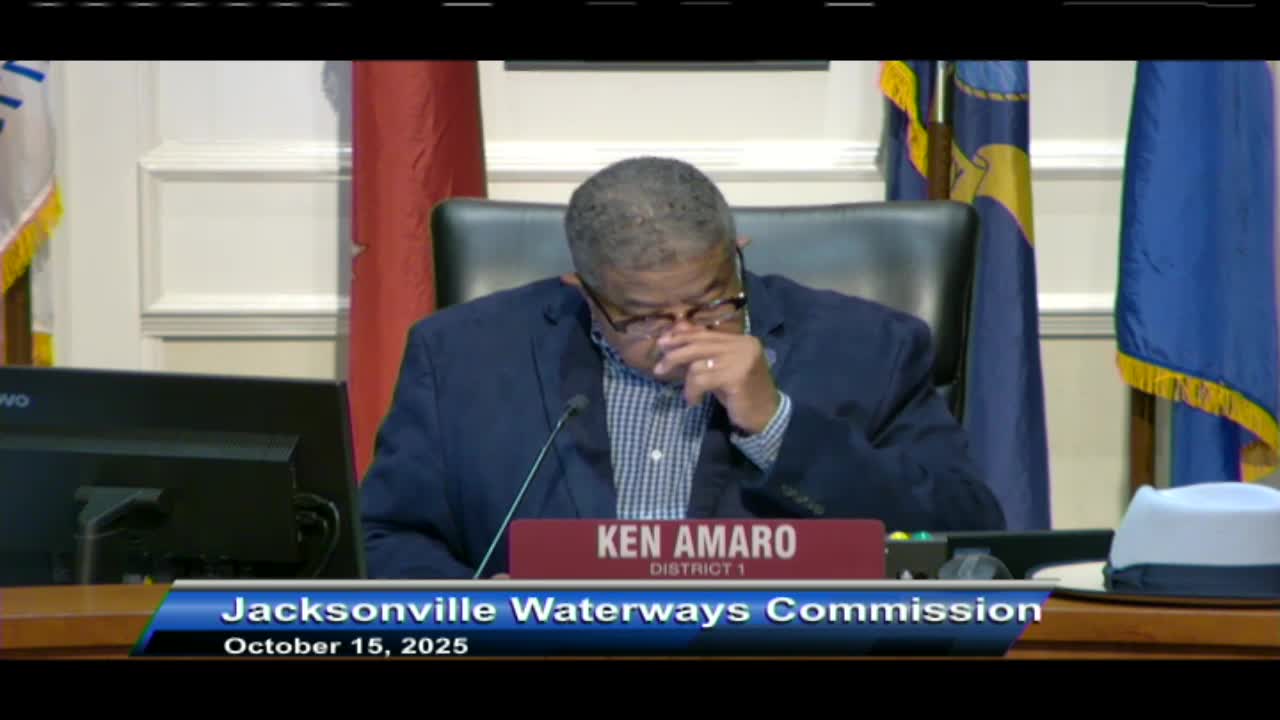Jacksonville expert: St. Johns River water quality stable; local manatee sightings tapering
October 15, 2025 | Jacksonville, Duval County, Florida
This article was created by AI summarizing key points discussed. AI makes mistakes, so for full details and context, please refer to the video of the full meeting. Please report any errors so we can fix them. Report an error »

Dr. Gerard Pinto of Jacksonville University reported on Oct. 15 to the Jacksonville Waterways Commission that recent measurements of salinity, temperature and algae in the St. Johns River are within typical ranges and currently show low toxin levels, and that local manatee sightings are declining as animals migrate south.
Pinto said water temperature is “running around 76 degrees” after higher readings last month and that salinity varies along the river: “Mayport salinity is around 20 to 27, Dames Point 15 to 20, JU 10 to 13 parts per thousand.” He said salinity at the Buckman Bridge has been higher than some recent lows—“we usually have more rain, but at the moment we're running at a deficit for the whole basin of around 5 inches”—but added these values are within the range the team commonly sees.
The manatee and algae picture, Pinto said, is mixed but not alarming for Northeast Florida. “With the cool down a little bit in the water temperature, that helps,” he said, and reported algae detections at Arlington, downtown and Mandarin Point with “no toxin observed.” On manatee mortality he summarized state figures, saying statewide deaths are up this season and noting the local pattern: “Latest flight I managed to do, in September there shows you 14 manatees in the area,” and that most animals are moving south as the region enters fall.
Why it matters: the Waterways Commission uses regular monitoring to guide local messaging, partner coordination and priorities for habitat protection. Pinto emphasized that temperature, salinity and residence time (how long water remains in a part of the system) strongly affect algal dynamics and seagrass condition. He noted some recovery of preferred seagrass (tape grass) in patches but cautioned that prolonged higher salinities can harm freshwater grass beds.
Commissioners asked about causes and responses. Commissioner Adam Hoyles asked why algal blooms had been limited this year despite ongoing nutrient concerns; Pinto said the system is dynamic and pointed to flushing and intermittent rainfall as factors that can prevent blooms from establishing. Commissioners also questioned the rise in watercraft-related manatee deaths statewide; Pinto clarified the state figures reflect multiple counties and said local coordination, education and harbor safety efforts are key to keeping local mortality low.
The Commission did not take formal action on the report. Pinto concluded by inviting questions and noting he would provide additional data on request.
The Commission moved on to public comment after the presentation.
Pinto said water temperature is “running around 76 degrees” after higher readings last month and that salinity varies along the river: “Mayport salinity is around 20 to 27, Dames Point 15 to 20, JU 10 to 13 parts per thousand.” He said salinity at the Buckman Bridge has been higher than some recent lows—“we usually have more rain, but at the moment we're running at a deficit for the whole basin of around 5 inches”—but added these values are within the range the team commonly sees.
The manatee and algae picture, Pinto said, is mixed but not alarming for Northeast Florida. “With the cool down a little bit in the water temperature, that helps,” he said, and reported algae detections at Arlington, downtown and Mandarin Point with “no toxin observed.” On manatee mortality he summarized state figures, saying statewide deaths are up this season and noting the local pattern: “Latest flight I managed to do, in September there shows you 14 manatees in the area,” and that most animals are moving south as the region enters fall.
Why it matters: the Waterways Commission uses regular monitoring to guide local messaging, partner coordination and priorities for habitat protection. Pinto emphasized that temperature, salinity and residence time (how long water remains in a part of the system) strongly affect algal dynamics and seagrass condition. He noted some recovery of preferred seagrass (tape grass) in patches but cautioned that prolonged higher salinities can harm freshwater grass beds.
Commissioners asked about causes and responses. Commissioner Adam Hoyles asked why algal blooms had been limited this year despite ongoing nutrient concerns; Pinto said the system is dynamic and pointed to flushing and intermittent rainfall as factors that can prevent blooms from establishing. Commissioners also questioned the rise in watercraft-related manatee deaths statewide; Pinto clarified the state figures reflect multiple counties and said local coordination, education and harbor safety efforts are key to keeping local mortality low.
The Commission did not take formal action on the report. Pinto concluded by inviting questions and noting he would provide additional data on request.
The Commission moved on to public comment after the presentation.
View full meeting
This article is based on a recent meeting—watch the full video and explore the complete transcript for deeper insights into the discussion.
View full meeting